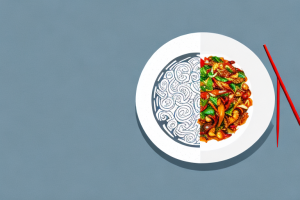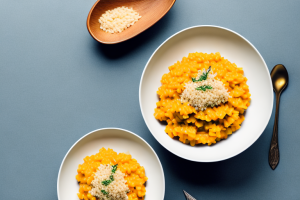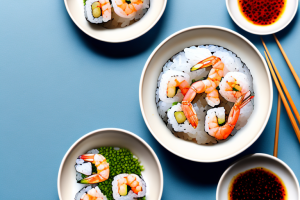How to cook wild rice with roasted vegetables
9 min read
A roasted vegetable medley with a bowl of cooked wild rice
Are you looking for a healthy and flavorful meal that’s easy to prepare? Look no further than wild rice with roasted vegetables! Not only is this dish delicious, it’s packed with nutrients that can help keep your body healthy. In this article, we’ll explore the health benefits of wild rice and roasted vegetables, how to prepare them, and some delicious serving suggestions. Let’s get started!
The health benefits of wild rice
Wild rice is a nutrient-rich grain that has been a staple food for many Native American tribes for centuries. It’s a good source of protein, fiber, and a variety of vitamins and minerals including vitamin B6, iron, and magnesium. Wild rice is also gluten-free, making it a great option for people with celiac disease or gluten sensitivity.
In addition to its nutritional benefits, wild rice also contains antioxidants that can help protect against chronic diseases such as heart disease, cancer, and diabetes. Studies have shown that the antioxidants in wild rice can help reduce inflammation in the body, which is a key factor in the development of these diseases. Additionally, wild rice has a low glycemic index, which means it can help regulate blood sugar levels and may be beneficial for people with diabetes.
Nutritional value of roasted vegetables
When it comes to getting your daily dose of vitamins and minerals, nothing beats roasted vegetables. Roasting vegetables helps to enhance their flavors and textures while maintaining their nutritional value. Vegetables like carrots, sweet potatoes, and broccoli are high in vitamins A, C, and K, and minerals like potassium and calcium. By incorporating roasted vegetables into your meal, you can boost your daily nutrient intake.
In addition to their high vitamin and mineral content, roasted vegetables are also a great source of dietary fiber. Fiber is important for maintaining digestive health and can also help to lower cholesterol levels. Roasting vegetables also helps to break down their tough fibers, making them easier to digest and absorb. So not only do roasted vegetables taste great and provide essential nutrients, but they also promote overall digestive health.
Choosing the right vegetables for roasting
When it comes to roasting vegetables, it’s important to choose the right ones. Vegetables that are higher in water content, such as zucchini and cucumbers, won’t roast well and could become mushy. Instead, opt for vegetables like sweet potatoes, beets, carrots, and broccoli. These vegetables have a lower water content and will roast well without becoming too soft.
Another important factor to consider when choosing vegetables for roasting is their size. Vegetables that are too small, like cherry tomatoes or baby carrots, may cook too quickly and become overcooked or burnt. On the other hand, vegetables that are too large, like whole heads of cauliflower or butternut squash, may take too long to cook and become dry.
Lastly, don’t be afraid to experiment with different seasonings and oils when roasting vegetables. While olive oil and salt are classic choices, you can also try using different herbs and spices like rosemary, thyme, or paprika to add more flavor. And for a healthier option, try using avocado oil or coconut oil instead of traditional vegetable oil.
The best cooking methods for wild rice
There are a few different methods you can use to cook wild rice, including stovetop, oven, and slow cooker. Stovetop cooking is the most common method and involves boiling the rice in a pot of water for approximately 40-50 minutes, or until the rice is tender. Oven cooking involves baking the rice in a covered dish with broth or water for approximately 1 hour at 350°F. Slow cooker cooking involves combining the rice with broth or water in a slow cooker and cooking on low for 4-6 hours. Choose the method that works best for you!
It’s important to note that the cooking time for wild rice can vary depending on the type and quality of the rice. Some wild rice may take longer to cook, while others may cook more quickly. It’s always a good idea to check the rice periodically while cooking to ensure that it doesn’t overcook or become too mushy.
Another tip for cooking wild rice is to add flavorings such as herbs, spices, or vegetables to the cooking liquid. This can help enhance the flavor of the rice and make it more enjoyable to eat. Some popular flavorings to add to wild rice include garlic, onion, thyme, and rosemary.
Preparing wild rice for cooking
Before cooking wild rice, it’s important to rinse it thoroughly in cold water. This helps to remove any debris or impurities that may be present. Once the rice is rinsed, you can add it to a pot or slow cooker with water or broth and cook according to your preferred method.
It’s worth noting that wild rice takes longer to cook than regular rice, so be sure to plan accordingly. Depending on the method you choose, it can take anywhere from 30 minutes to an hour or more to fully cook. You may also want to consider soaking the rice overnight to help reduce the cooking time.
Wild rice is a nutritious and versatile ingredient that can be used in a variety of dishes, from salads to soups to casseroles. It’s high in protein, fiber, and antioxidants, making it a great addition to any healthy diet. Plus, its nutty flavor and chewy texture add a unique touch to any meal.
How to roast vegetables to perfection
When it comes to roasting vegetables, there are a few tips to keep in mind. First, be sure to cut the vegetables into similar-sized pieces so that they cook evenly. Second, toss the vegetables with a little bit of oil and any desired herbs or spices to add flavor. Finally, spread the vegetables out on a baking sheet and roast at 400°F for approximately 25-30 minutes, or until they are tender and caramelized.
One additional tip to keep in mind is to not overcrowd the baking sheet. If the vegetables are too close together, they will steam instead of roast, resulting in a less crispy texture. It’s better to use two baking sheets if necessary, to ensure that the vegetables have enough space to roast properly. Additionally, you can experiment with different vegetables and seasonings to create unique flavor combinations. Some great options to try include roasted Brussels sprouts with balsamic glaze, or roasted sweet potatoes with cinnamon and honey.
Adding herbs and spices to enhance flavor
To enhance the flavor of your wild rice and roasted vegetables, consider adding herbs and spices. Rosemary, thyme, and sage are all great options for roasted vegetables, while garlic and onion powder can be added to the wild rice to add depth of flavor. Don’t be afraid to get creative with your seasonings!
Additionally, you can also try adding some fresh herbs like parsley, cilantro, or basil to your dish. These herbs not only add flavor but also provide a pop of color to your dish. Another great option is to use spice blends like curry powder, garam masala, or za’atar to add a unique and exotic flavor to your dish. Experiment with different combinations of herbs and spices to find your perfect flavor profile!
Serving suggestions for wild rice with roasted vegetables
Once your wild rice and roasted vegetables are ready, it’s time to serve them up! You can enjoy them on their own as a complete meal or pair them with some protein like roasted chicken or grilled tofu for a more filling dish. You can also add some fresh herbs like parsley or cilantro on top for an extra burst of flavor.
If you’re looking to add some crunch to your dish, you can sprinkle some toasted nuts like almonds or pecans on top. This will not only add texture but also some healthy fats to your meal. Another option is to drizzle some balsamic glaze or vinaigrette on top for a tangy and sweet flavor.
If you have any leftovers, you can store them in an airtight container in the fridge for up to three days. To reheat, simply microwave for a few minutes or heat up in a pan on the stove. You can also use the leftovers as a base for a salad by adding some greens and a dressing of your choice.
Tips for meal prep and storage
If you’re looking to meal prep, wild rice and roasted vegetables are a great option. You can cook both ahead of time and store them in the fridge for up to 4-5 days. When you’re ready to eat, simply reheat them in the microwave or oven and enjoy!
Another great option for meal prep is to make a big batch of quinoa salad. Quinoa is a great source of protein and can be mixed with a variety of vegetables and dressings to create a delicious and healthy meal. You can store the salad in the fridge for up to 3-4 days and it’s perfect for a quick lunch or dinner on the go.
Vegan and gluten-free options
For those following a vegan or gluten-free diet, wild rice with roasted vegetables is a great option. Simply ensure that any broth or seasoning used in the dish is vegan and that the wild rice is labeled gluten-free.
Additionally, we offer a variety of salads that are both vegan and gluten-free. Our house salad includes mixed greens, cherry tomatoes, cucumber, and a balsamic vinaigrette dressing. We also have a quinoa salad with roasted vegetables and a lemon herb dressing. Both options are delicious and satisfying for those with dietary restrictions.
One-pot meal idea with wild rice and roasted vegetables
If you want to simplify your cooking process, consider making a one-pot meal with wild rice and roasted vegetables. Simply cook the wild rice in a pot and add roasted vegetables directly to the pot when they’re finished cooking. This saves time and makes for easy cleanup!
Not only is this one-pot meal idea convenient, but it’s also packed with nutrients. Wild rice is a great source of fiber, protein, and various vitamins and minerals. Roasted vegetables, such as sweet potatoes, carrots, and Brussels sprouts, are also loaded with vitamins and antioxidants. Plus, the combination of wild rice and roasted vegetables creates a delicious and satisfying meal that will keep you full for hours.
Using leftovers in creative ways
If you have leftover wild rice and roasted vegetables, there are plenty of creative ways to use them up. You can add them to salads, use them as a filling for wraps or sandwiches, or even use them to make a hearty breakfast bowl. Don’t let your leftovers go to waste!
Wild rice salads with roasted vegetables
If you’re looking for a lighter meal, consider making a wild rice salad with roasted vegetables. Simply mix cooked wild rice with roasted vegetables, fresh herbs, and a dressing of your choice. This makes for a tasty and healthy lunch or side dish.
Frequently asked questions about cooking wild rice with roasted vegetables
Here are a few frequently asked questions about cooking wild rice with roasted vegetables:
- Can I use different vegetables for roasting?
- Yes! You can use a variety of vegetables for roasting, just be sure to choose ones with a lower water content to avoid mushiness.
- Can I cook wild rice in a rice cooker?
- Yes! You can cook wild rice in a rice cooker using a 2:1 ratio of water to rice.
- Can I freeze wild rice and roasted vegetables?
- Yes! You can freeze both wild rice and roasted vegetables for up to 3 months. Just be sure to store them in an airtight container.
We hope this article has inspired you to try cooking wild rice with roasted vegetables. With their delicious flavors and abundant health benefits, this is a dish that’s sure to become a staple in your meal rotation. Enjoy!


